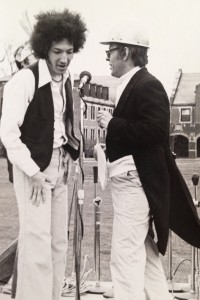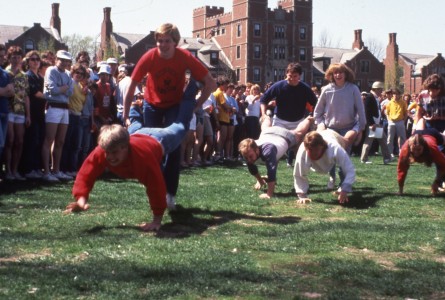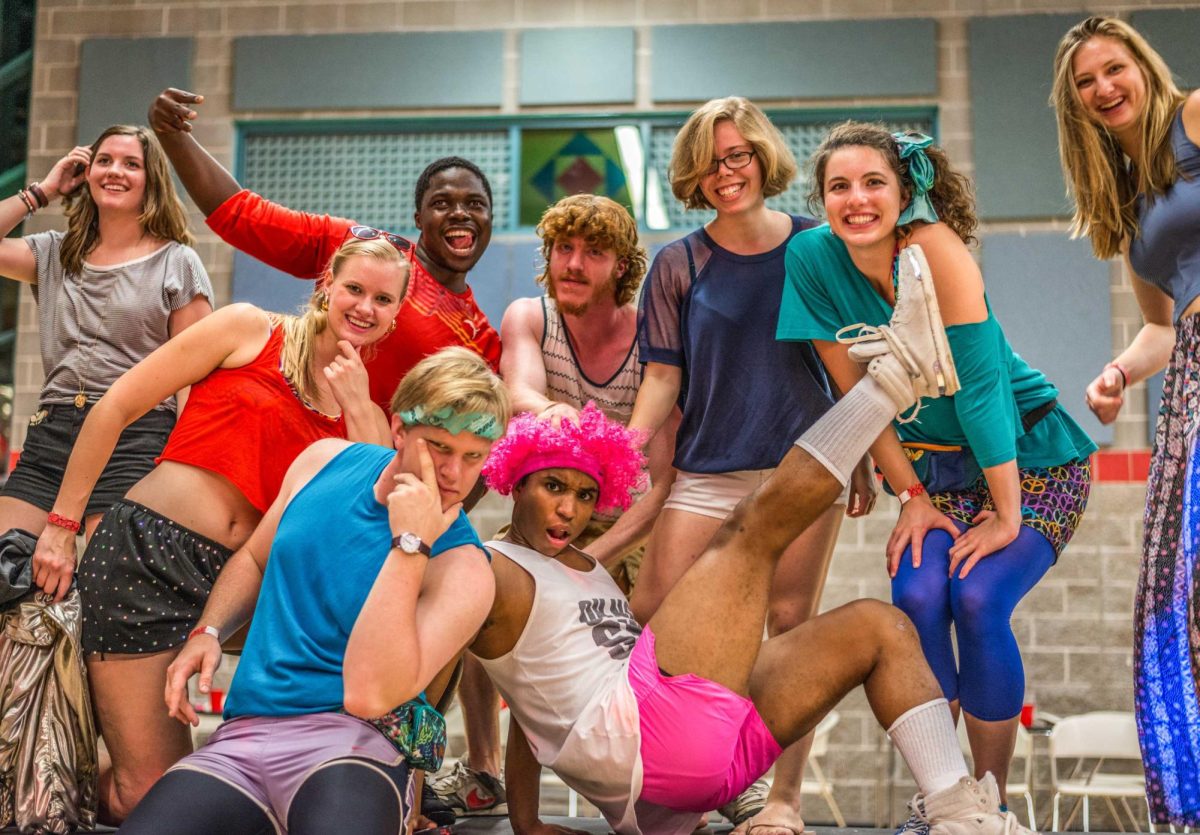When Wayne Moyer came to teach Political Science at Grinnell in 1973, fresh from earning a Ph.D. from Yale University, he carried with him the seeds of a tradition that has come to be a hallmark of Grinnell lore. That year, together with two students, Moyer organized the first Grinnell Relays—a festival replete with obstacle courses, beer and a roast pig. The inspiration, however, for the first Relays came from Moyer’s last year at Yale in 1972.
“During my last year at Yale, the Vietnam War looked like it was winding down and students were ready to let off a little steam at the end of the semester,” Moyer explained. “And because there was nothing in particular to demonstrate against or protest, they thought ‘Why not have a big party?’ [We] essentially had a Sunday school picnic with beer.”

Photo contributed.
Moyer suspects that Grinnell’s administration was happy that the Relays happened that year: “I think they were relieved that we had a big picnic rather than a demonstration, because the year before students had taken over Burling Library.”
They were at once a dastardly counter to the Drake Relays, a large track meet that takes place at Drake University in Des Moines during the same time of year, and an opportunity for enlightened debauchery. A set of judges attempts to make sense of the day’s madness and declare a Grinnell Relays winner, but their decision-making criteria are unclear. Allison Moore ’13 faced this confusion in 2010.
“My first year at Grinnell, I was a little naïve in believing the winner of Relays actually won all the events,” Moore said in an email. “That year, my team certainly won every event, but I later found that the secret of running Relays is that the winner is actually dependent on losing, but losing well.”
David Blatt ’80 managed to charm the judges during his “moment of glory” at the 1979 Relays.
“Three of us had met in the 1976 Moyer tutorial, and we strove to uphold the high standards of intellectual rigor and sartorial distinction set by H. Wayne himself,” Blatt wrote in an email. “So, instead of showing up on stage blind drunk and doing what came naturally, we obtained the services of Carolyn Miller Schultz ’80 to teach us the YMCA choreography and help with our costumes, which included stuffing towels and other items in our underwear to create bulging crotches à la Spinal Tap.”
However, the fun didn’t stop there.
“Most unusually, we actually practiced, so that when the big night arrived we stunned the judges with our precision, our stage presence, and our simulated sex acts, and won by acclamation,” Blatt added.
With the judges changing every year, it is up to Professor Moyer to maintain a degree of continuity between Relays. Whenever he is on campus, Moyer serves as Master of Ceremonies, donned in a bright gold hard hat from his Navy days, as he addressed the eagerly awaiting teams. His speech before the 2004 Relays explained to the students its history and raison d’etre: “[The founders] saw life at Grinnell all too often centering on cutthroat competition, grade grubbing, scholastic strangulation, intense intellectualism and raw educational endurance. They felt that some of the most important qualities were left untested, and the Relays were designed to measure and reward some of these crucial skills. Our battle cry was “Beer is back and back big.””
The late 1970s and 1980s were a golden period for the Relays as students congregated on Mac Field from all sides of campus—jumping through tires, hitting each other with foam sticks and making human pyramids. There was even a parade one year, complete with a kazoo marching band. The drinking age then was 18 and beer flowed readily, such as during the Babe Ruth Bat Relay, which had contestants chug a beer, run to a vertically-held baseball bat, put their heads on the top and spin 10 times before running back.
“The relay was a study in parabolic trajectories,” Moyer recalled. “You get quite dizzy.”
For Moyer, various images stand out when he recollects Relays past. During one North versus South Campus tug-of-war competition, the rope snapped and hundreds of Grinnellians tumbled into each other like falling dominoes.
Another year, so many students were tossed into the mud pit in the middle of the tug-of-war contest that “the showers later got clogged with mud—that created some problems for Student Affairs,” Moyer said. “So one year the Grinnell Relays Committee did away with the pit, but there was an anti-committee that said ‘We’re going to dig one anyways’ and they dug it and then the Relays Committee collaborated with Student Affairs to fill the hole with cement.”
As the Grinnell Relays increased in participation and importance, so did the amount of beer consumed. According to Moyer, for the first couple years, three kegs of beer were present, but by the late 1970s, 20 to 25 kegs were consumed. And though a huge portion of the campus community attended, there were several incidents of students drinking too much. The change to a 21-only drinking law in 1987 then turned the revelries dry.
“The changed drinking age put a curtain on [the Relays] for a while,” Moyer said. “It came back in the 1990s, but it was never quite like it was in the 70s and 80s—and part of that is good because there is not as much alcohol involved. In some ways, Relays today is closer to the original because people don’t drink as much.”
Organizing the Grinnell Relays this year are Hayes Gardner ’15 and Ryan Hautzinger ’15. Hautzinger’s father actually had Moyer as an advisor when he was a student at Grinnell. The two are looking back at past years for inspiration for activities.
“The Grinnell Relays Committee has to have a decent knowledge of what has happened before and based on those events, you add new events and remodel old ones,” Hautzinger explained.

Photo contributed.
Thus, to participate in the Grinnell Relays is to be a part of a tradition that connects the present to the past. Although new layers are added every year and the rituals evolve, Grinnell students are given the chance to subject themselves to the same challenges as their forebears, if only for a day.
“Both of my parents were here in the 1980s and told me about the bat relay,” Hautzinger recalls. “It’s one of the best.”
The Grinnell Relays will occur on Apr. 26.


















































